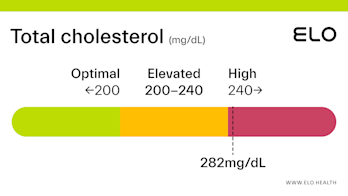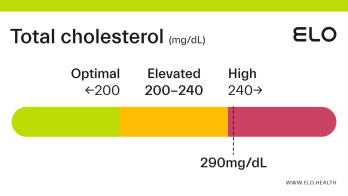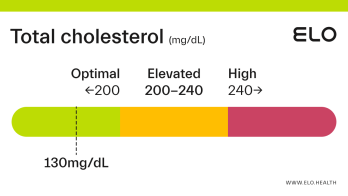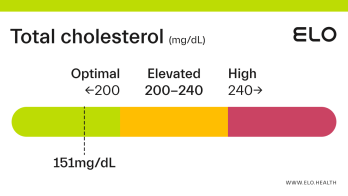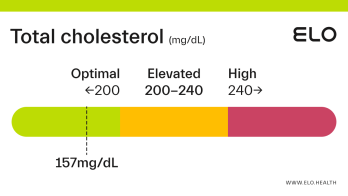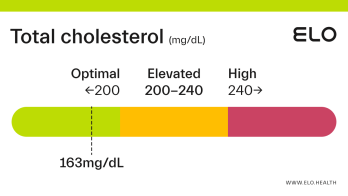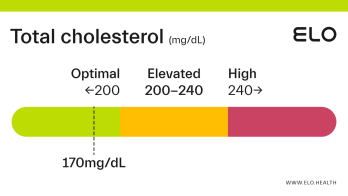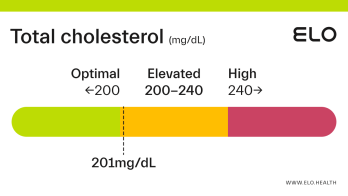Total Cholesterol: 2.4 mmol/L (93mg/dL)
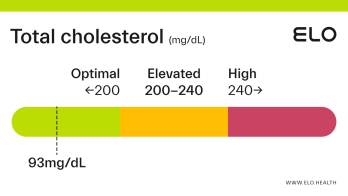
What does a total cholesterol level of 2.4 mean?
A total cholesterol level of 2.4 mmol/L is considered optimal and is associated with better heart health and a lower risk of heart disease.
Total cholesterol is calculated by adding your LDL (bad) cholesterol, HDL (good) cholesterol, and 20% of triglyceride levels.
LDL is commonly referred to as “bad” cholesterol because it accumulates in the blood vessels and increases your risk for heart disease. Ideally, LDL levels should be less than 2.6 mmol/L (101 mg/dL), but lower is better.
HDL is considered “good” cholesterol because it protects against heart disease by scavenging cholesterol in the blood and returning it to the liver for excretion. The ideal HDL level is >1.5 mmol/L (58 mg/dL), though >1.0 mmol/L for men and >1.3 mmol/L for women are still considered good. Opposite of LDL, the higher your HDL, the better.
Triglycerides are another type of fat that can build up in the bloodstream and increase your risk of heart disease. Ideally, triglyceride levels should be <1.7 mmol/L (151 mg/dL).
How to maintain optimal total cholesterol levels
Maintaining a healthy total cholesterol level is good for your overall health and can lower your risk of developing heart disease in the future.
Because cholesterol levels tend to increase with age it’s best to put heart-healthy habits into place now. Here are some things you can do to help keep your levels in the optimal range:
Eat plenty of fruits, veggies, whole grains, and legumes, aiming to get 30-40g of fiber each day.
Limit refined carbs and added sugars in your diet, like those found in soda, chips, candy, baked goods, sweetened yogurt, and ice cream.
Avoid trans fats (partially hydrogenated oils) and reduce saturated fat intake to <10% of total calories.
Eat small, fatty fish like salmon, sardines, and trout, at least twice a week.
Exercise for 30-60 minutes most days of the week.
Incorporate plant sterols and stanols daily (2g) in the form of food or a supplement.
Lose weight if you are overweight or obese.
Quit smoking if you currently smoke.
If you have diabetes, achieve and maintain good blood sugar control (HbA1c).
References
Cholesterol Levels: What You Need to Know. (n.d.). U.S. National Library of Medicine | NIH. Retrieved September 9, 2021, from
https://medlineplus.gov/cholesterollevelswhatyouneedtoknow.html
Carotid Artery Disease. (n.d.). National Heart, Lung, and Blood Institute | NIH. Retrieved September 9, 2021, from
https://www.nhlbi.nih.gov/health-topics/carotid-artery-disease
High cholesterol. (n.d.). NHS Inform. Retrieved September 9, 2021, from
https://www.nhsinform.scot/illnesses-and-conditions/blood-and-lymph/high-cholesterol
Racette, S. B., Lin, X., Lefevre, M., Spearie, C. A., Most, M. M., Ma, L., & Ostlund, R. E., Jr (2010). Dose effects of dietary phytosterols on cholesterol metabolism: a controlled feeding study. The American journal of clinical nutrition, 91(1), 32–38.
https://doi.org/10.3945/ajcn.2009.28070
Cholesterol: Types, Tests, Treatments, Prevention. (2020, July 31). Cleveland Clinic.
https://my.clevelandclinic.org/health/articles/11920-cholesterol-numbers-what-do-they-mean


